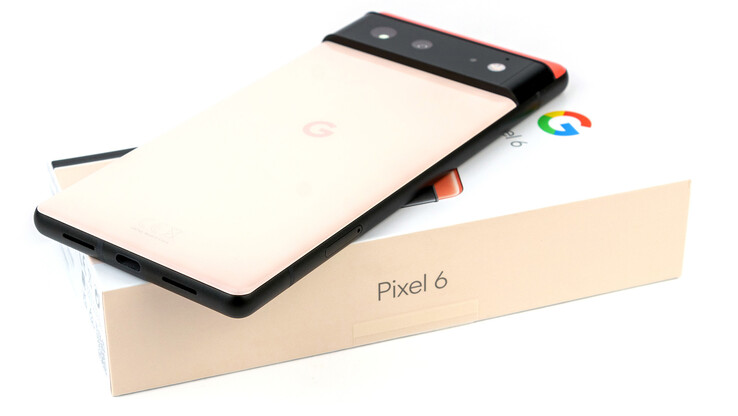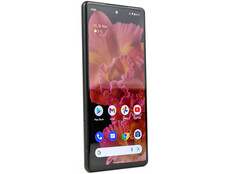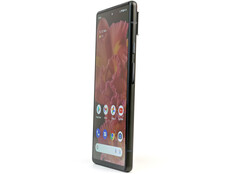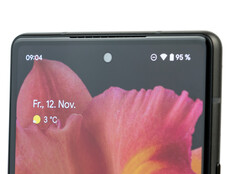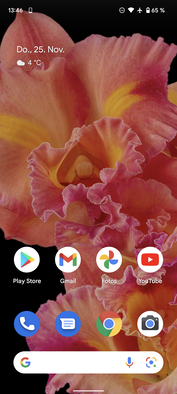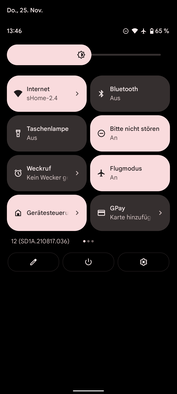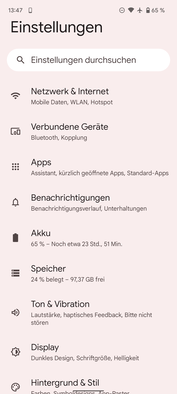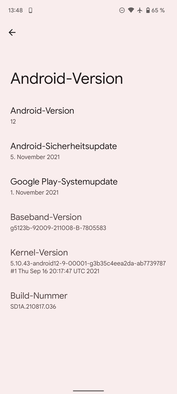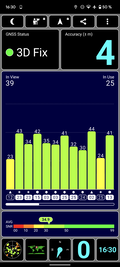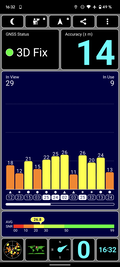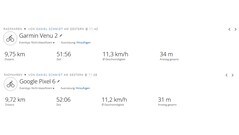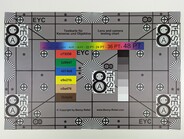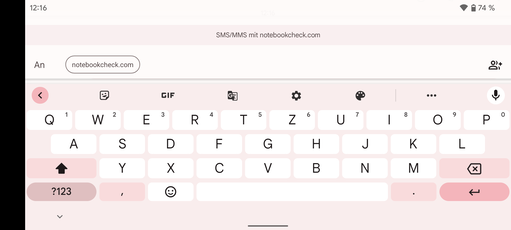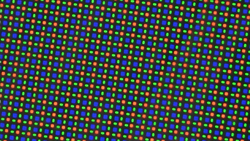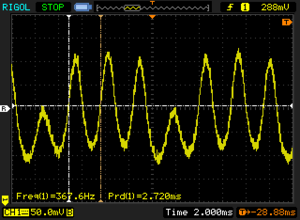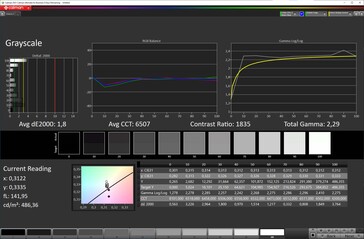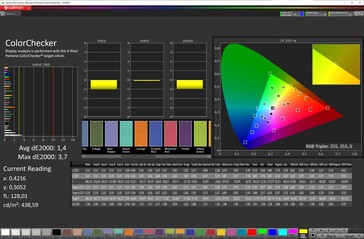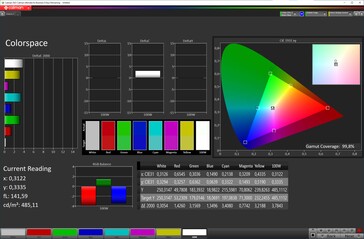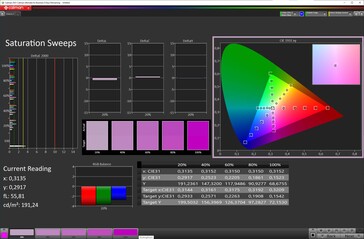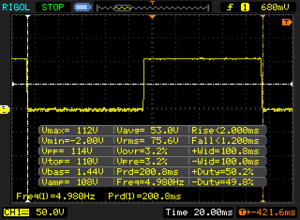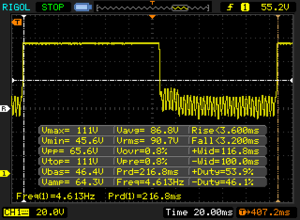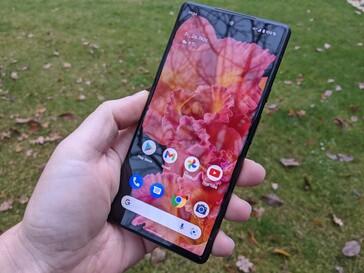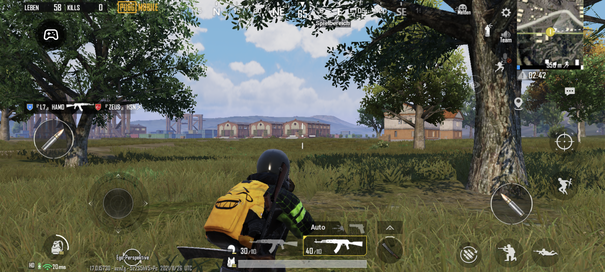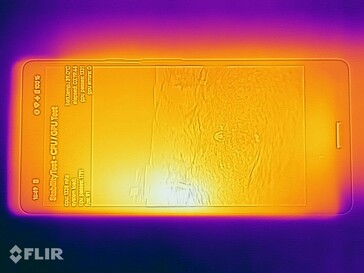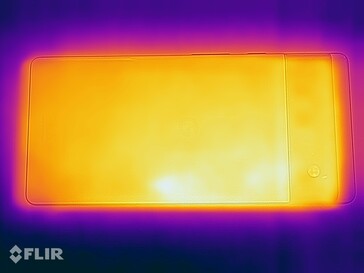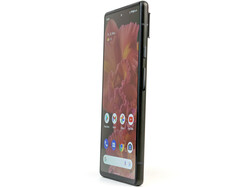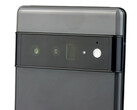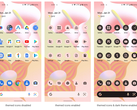Google Pixel 6 review: Strong smartphone with long update cycle
Not only does Google focus on a lot of high-end specs in its new top model, but it also integrates its in-house Tensor chipset for the first time. Furthermore, there's once again a Pro variant available alongside the Pixel 6. The latter is a bit bigger than our test device, has a 120 Hz panel with narrower bezels and a higher resolution, more RAM, a larger battery, and an additional zoom lens (48 MP, 4x zoom).
The Pixel 6 is equipped with 8 GB of RAM and 128 GB of internal storage; an expansion via a microSD card remains unavailable. A brand-new dual-camera setup is found on the back, and the battery has a capacity of 4,614 mAh. In terms of price, the Google smartphone starts at an MSRP of $599. The Pro model is available starting at $899 in the 128 GB version, and it's alternatively also available with 256 GB for $999.
Possible contenders in comparison
Rating | Date | Model | Weight | Drive | Size | Resolution | Price |
|---|---|---|---|---|---|---|---|
| 87.4 % v7 (old) | 11 / 2021 | Google Pixel 6 Tensor, Mali-G78 MP20 | 207 g | 128 GB UFS 3.1 Flash | 6.40" | 2400x1080 | |
| 89.6 % v7 (old) | 02 / 2021 | Samsung Galaxy S21+ Exynos 2100 5G, Mali-G78 MP14 | 200 g | 128 GB UFS 3.1 Flash | 6.70" | 2400x1080 | |
| 87.3 % v7 (old) | 02 / 2021 | Xiaomi Mi 11 SD 888 5G, Adreno 660 | 196 g | 128 GB UFS 3.1 Flash | 6.81" | 3200x1440 | |
| 88.7 % v7 (old) | 10 / 2021 | Apple iPhone 13 A15, A15 GPU 4-Core | 173 g | 128 GB NVMe | 6.10" | 2532x1170 | |
| 83.8 % v7 (old) | 10 / 2021 | Oppo Reno6 5G Dimensity 900, Mali-G68 MP4 | 182 g | 128 GB UFS 2.1 Flash | 6.43" | 2400x1080 | |
| 85.9 % v7 (old) | 06 / 2021 | Asus ZenFone 8 SD 888 5G, Adreno 660 | 169 g | 256 GB UFS 3.1 Flash | 5.92" | 2400x1080 |
Case - Compact phones are a thing of the past
If you own a Google Pixel 5, you'll be surprised at how heavy the new Pixel 6 has become. It weighs 207 grams, which is 56 grams more than the predecessor. This is mostly due to the larger dimensions, the bigger battery, and the glass on the front and back. The glass on both sides is Corning Gorilla Glass Victus.
The cameras on the back are also eye-catching. The thick camera hump protrudes by an impressive 2.85 millimeters, but it keeps the Pixel 6 stable on flat surfaces. There's no room for criticism in terms of build quality. The matte metal frame isn't susceptible to fingerprints, but this isn't the case for the glass. The gap dimensions are tight and even, and the Google smartphone leaves a very sturdy impression when it comes to twisting attempts.
The SIM slot's cover sits flush with the frame. Both plastic and metal are used for the card slot, which looks sufficiently stable and can hold a nano SIM card. The Pixel 6 is IP68 certified and therefore resistant to dust and water. The phone is available in Stormy Black, Sorta Seafoam, and Kinda Coral, the latter being our review sample.
Connectivity - USB 3.2 in the Pixel 6
The Google Pixel is equipped with a fast USB 3.2 port (Gen. 1), which allows for high data speeds and supports OTG, but it doesn't support wired image output. Bluetooth 5.2 and NFC are also on board.
Apart from that, Google stays true to the predecessor's build by offering a very basic configuration. There's no microSD support, notification LED, IR blaster, radio receiver, or anything of the sort.
Software - Android 12 with 5 years of updates
Google opts for a pure Android 12 experience and spices it up with a few exclusive Pixel features. For instance, offline chats can be translated in real time in up to 55 languages. Unfortunately, the feature is only limited to a few apps so far.
The Magic Eraser is a tool that allows you to retouch unwanted elements in photos. This usually works quite well, although the Pixel 6 doesn't always apply the proper background fill to the corrected area when the image content is more complex.
Not only does the Google smartphone have DRM certification, but it also has a new codec on board: HDRnet.
The Pixel is supposed to receive Android version and feature updates for a minimum of three years, and security updates are even supposed to be deployed for at least five years. This time frame started when the Pixel 6 was added to the US Google Store. Consequently, nothing should stand in the way of an update to Android 15.
Communication and GNSS - The Pixel 6 doesn't come with mmWave in all markets
The Google Pixel 6 can access mobile networks using all common mobile standards. Only 5G is limited by the manufacturer to the Sub-6 range in most regions. The mmWave standard is only available in the USA, Japan, and Australia. In view of the potentially long lifespan of the Pixel smartphone, this decision is hard to understand. According to various teardowns, only one mmWave antenna is installed in the G9S9B models, which is located in the phone's top area. The frequency band coverage for the available standards is very broad, making it possible to establish mobile connections with the Pixel 6 all over the world.
With Wi-Fi 6E, the Google smartphone supports the most modern WLAN standard. The Pixel impresses in everyday use with a stable connection and a pretty good range. The former is also confirmed by the test with our Netgear Nighthawk AX12 reference router. However, transfer speeds are a bit too low, especially for sending data.
The satellite signal is obtained very quickly outdoors, but it could be a bit more precise. The Google Pixel 6 takes a bit longer indoors, and the GNSS signal is only very weak.
During our short bike ride, the Google phone has to face a comparison with the Garmin Venu 2. The smartwatch shows a much more accurate route tracking, but the smartphone's performance is sufficient for navigation tasks.
Telephone and call quality
The Google Pixel 6 can hold one nano SIM card. Users who want to use dual SIM cards can resort to an additional eSIM. Features like VoLTE and Wi-Fi calling are supported.
Voice quality is very good when the Google smartphone is held to the ear. The user's voice is transmitted very naturally, and interfering background noise is accurately filtered out after a short time without this leading to changes in the color of the voice. The three microphones and the implemented algorithms do an excellent job in this regard.
The speakerphone mode doesn't work as well. Although the user of the Pixel 6 can be understood well, their voice sounds muffled and hollow. In addition, the range of the microphones is only average.
Cameras - Powerful dual-camera setup in the Pixel 6
The front-facing camera of the Google Pixel 6 takes good selfies. The scene detection immediately suggests a portrait shot, which can also be comprehensively edited afterwards. Despite the lack of a monstrous resolution, the results look detailed and homogeneous. The only drawback is the lack of autofocus.
A lot has changed on the back, since Google has updated the main sensor for the first time in years by implementing a 50 MP Samsung ISOCELL GN1 sensor that works with pixel-binning, resulting in 12.5 MP photos. The lens is absolutely compelling during the day, and the Pixel 6 takes detailed and color-consistent pictures that don't overdo it, especially in terms of sharpness. The imaging performance is still good in low light, but it doesn't quite match the rivals from Apple and Samsung. Night Mode makes things a bit better, but even then, the two contenders mentioned above are a bit more detailed. The additional ultra-wide angle lens delivers good results with an appealing depth of field. There might be minimal aberrations when it comes to the edges, though.
Videos can be recorded in Ultra HD at up to 60 frames per second at best. Thanks to the optical image stabilizer (OIS) and the additional electronic stabilization, recordings remain very smooth.
Image comparison
Choose a scene and navigate within the first image. One click changes the position on touchscreens. One click on the zoomed-in image opens the original in a new window. The first image shows the scaled photograph of the test device.
Main cameraMain cameraUltra-wide angle5x zoomLow lightUnder controlled lighting conditions, the Google Pixel 6's camera shows a slightly warmer white balance, but without overdoing it. Colors are often displayed a bit brighter, but the deviations from the DeltaE value are a bit too high when it comes to blues and dark skin in particular.
Our test chart is captured with a lot of detail, and the Google smartphone doesn't reveal any weaknesses even in the peripheral areas.
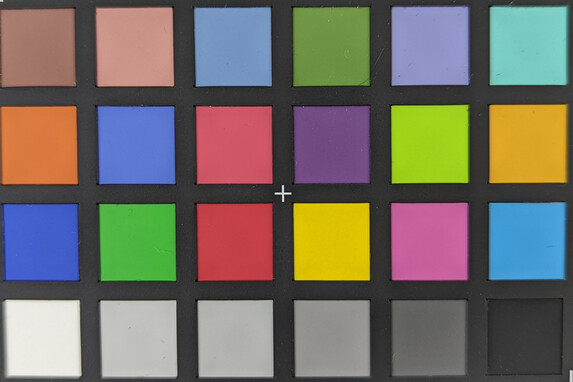
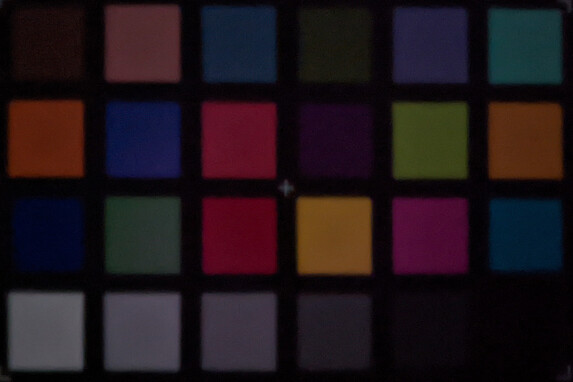
Accessories and warranty - No charger is included now
The Google Pixel 6 comes with a 24-month warranty that can't be extended or upgraded.
The accessories in the box are modest, as Google doesn't include a charger. As a result, only a USB-C cable, a SIM tool, and an OTG adapter are included in the box apart from the smartphone itself. The manufacturer offers an optional 30-watt charger ($25), compatible plastic or leather cases ($29 and $49, respectively), and the Pixel Stand (2nd generation, $79), which can be used to charge the Pixel wirelessly.
Input devices and handling - The fingerprint sensor migrates into the display
The capacitive touchscreen of the Google Pixel 6 recognizes up to 10 simultaneous taps, and it responds to them quickly and accurately. The glass surface has very good gliding properties and is very pleasant to the touch. We like the vibration motor very much, and it pleases with a crisp feedback.
Google finally decided to provide Android with a one-handed mode. This has to be enabled in the settings first, but then a simple swipe downwards from the bottom edge of the screen is all it takes to reduce the image.
In contrast to the Pixel 5, Google is no longer using a fingerprint sensor located on the back, but instead, it has been moved to the front of the display. The optical sensor works reliably and unlocks the smartphone at an agreeable speed. Only when the panel is completely off does it first have to be woken up for the sensor to become active.
Display - Pixel 6 with impressive OLED panel
The Google Pixel 6 has a 6.4-inch (16.26 cm) OLED display with a resolution of 2400x1080 pixels and an attractive pixel density. The panel works at up to 90 Hz, but it can only reduce the refresh rate to 60 Hz. HDR support is limited to HLG and HDR10. An always-on display is available.
The panel's brightness is excellent, averaging around 805 cd/m² with a pure white background and the ambient light sensor enabled. It even reaches 1,128 cd/m² with an even distribution of bright and dark areas (APL50). If the ambient light sensor is disabled, up to 485 cd/m² is available.
However, Google doesn't have a particularly good grip on OLED flickering. There's neither a DC-dimming mode, nor is anything similar directly integrated into the panel's settings. The display flickers unsteadily between 176.1 Hz and 376.6 Hz at minimum brightness. At higher brightness, the amplitude curve becomes increasingly flatter and only fluctuates between 352.1 Hz and 376.6 Hz at maximum settings. This means that sensitive users will have to deal with discomfort during use, and even the optional Night Light mode will only help to a limited extent.
| |||||||||||||||||||||||||
Brightness Distribution: 98 %
Center on Battery: 805 cd/m²
Contrast: ∞:1 (Black: 0 cd/m²)
ΔE ColorChecker Calman: 1.4 | ∀{0.5-29.43 Ø4.78}
ΔE Greyscale Calman: 1.8 | ∀{0.09-98 Ø5}
99.8% sRGB (Calman 2D)
Gamma: 2.29
CCT: 6507 K
| Google Pixel 6 OLED, 2400x1080, 6.4" | Google Pixel 5 OLED, 2340x1080, 6" | Samsung Galaxy S21+ Dynamic AMOLED 2X, 2400x1080, 6.7" | Xiaomi Mi 11 LED DotDisplay, 3200x1440, 6.8" | Apple iPhone 13 OLED, 2532x1170, 6.1" | Oppo Reno6 5G AMOLED, 2400x1080, 6.4" | Asus ZenFone 8 AMOLED, 2400x1080, 5.9" | |
|---|---|---|---|---|---|---|---|
| Screen | 8% | -3% | 7% | 24% | -42% | -30% | |
| Brightness middle (cd/m²) | 805 | 635 -21% | 814 1% | 840 4% | 831 3% | 588 -27% | 758 -6% |
| Brightness (cd/m²) | 805 | 636 -21% | 814 1% | 845 5% | 830 3% | 593 -26% | 759 -6% |
| Brightness Distribution (%) | 98 | 97 -1% | 97 -1% | 98 0% | 98 0% | 98 0% | 98 0% |
| Black Level * (cd/m²) | |||||||
| Colorchecker dE 2000 * | 1.4 | 0.8 43% | 2 -43% | 1.2 14% | 0.77 45% | 2.6 -86% | 3.5 -150% |
| Colorchecker dE 2000 max. * | 3.7 | 2.2 41% | 3.6 3% | 2.7 27% | 1.52 59% | 4.7 -27% | |
| Greyscale dE 2000 * | 1.8 | 1.7 6% | 1.4 22% | 2 -11% | 1.2 33% | 3.3 -83% | 1.6 11% |
| Gamma | 2.29 96% | 2.23 99% | 2.12 104% | 2.26 97% | 2.209 100% | 2.19 100% | 2.23 99% |
| CCT | 6507 100% | 6492 100% | 6568 99% | 6492 100% | 6501 100% | 6573 99% | 6527 100% |
* ... smaller is better
Screen Flickering / PWM (Pulse-Width Modulation)
| Screen flickering / PWM detected | 367.6 Hz | ≤ 100 % brightness setting | |
The display backlight flickers at 367.6 Hz (worst case, e.g., utilizing PWM) Flickering detected at a brightness setting of 100 % and below. There should be no flickering or PWM above this brightness setting. The frequency of 367.6 Hz is relatively high, so most users sensitive to PWM should not notice any flickering. However, there are reports that some users are still sensitive to PWM at 500 Hz and above, so be aware. In comparison: 53 % of all tested devices do not use PWM to dim the display. If PWM was detected, an average of 8111 (minimum: 5 - maximum: 343500) Hz was measured. | |||
Color reproduction is a bit less accurate than in the Pixel 5, but this is nitpicking because the deviations are still so small that only a very trained eye would notice them in isolated cases.
Color-space coverage is a bit lower than expected in the measurements with CalMAN, because the Pixel 6 targets an extended sRGB color space instead of the more common DCI-P3. This is probably only used when necessary.
Display Response Times
| ↔ Response Time Black to White | ||
|---|---|---|
| 3.2 ms ... rise ↗ and fall ↘ combined | ↗ 2 ms rise | |
| ↘ 1.2 ms fall | ||
| The screen shows very fast response rates in our tests and should be very well suited for fast-paced gaming. In comparison, all tested devices range from 0.1 (minimum) to 240 (maximum) ms. » 13 % of all devices are better. This means that the measured response time is better than the average of all tested devices (20.2 ms). | ||
| ↔ Response Time 50% Grey to 80% Grey | ||
| 6.8 ms ... rise ↗ and fall ↘ combined | ↗ 3.6 ms rise | |
| ↘ 3.2 ms fall | ||
| The screen shows very fast response rates in our tests and should be very well suited for fast-paced gaming. In comparison, all tested devices range from 0.165 (minimum) to 636 (maximum) ms. » 18 % of all devices are better. This means that the measured response time is better than the average of all tested devices (31.6 ms). | ||
Thanks to the high brightness, there should hardly be any problems when using the Google Pixel 6 outdoors, even on sunny days. In addition, the ambient light sensor works very conservatively, and it also learns from the user's fine-tuning over time.
The viewing-angle stability of the OLED panel is just as impressive. At flat viewing angles, only a minor loss of brightness is noticeable.
Performance - Tensor makes for a strong Google debut
The Pixel 6 is the first Google smartphone to be powered by an in-house SoC - the Google Tensor. Its architecture is somewhat reminiscent of the Samsung Exynos 2100, but it has an additional Cortex-X1 core and one less A76 core. Furthermore, Google has implemented the Titan M2 coprocessor, which is said to provide additional security; likewise, the algorithms for machine learning are supposed to have been greatly improved. An ARM Mali-G78 is used as the graphics unit. In contrast to the Galaxy S21+, however, it has 20 cores instead of 14.
The powerful SoC makes for an appealing performance in everyday use. However, it ranks behind the Snapdragon 888 in the benchmarks. The Qualcomm chipset is particularly faster when it comes to the CPU's multi-core performance. The GPU performance is quite different. While older OpenGL benchmarks in 3DMark show weaker results than with the Adreno 660, the performance is mostly higher with the Vulkan API. Only in GFXBench is the performance consistently weaker than that of the Qualcomm chip. The situation is similar compared to the Exynos SoC, which is probably due to heat development as we will see in the Temperature section.
In terms of the chip's AI capabilities, the AIMark results are very disappointing since the score is very low. Things look different in the Procyon AI benchmark, where the Tensor is on par with the SD888.
| PCMark for Android - Work 3.0 (sort by value) | |
| Google Pixel 6 | |
| Oppo Reno6 5G | |
| Asus ZenFone 8 | |
| Average Google Tensor (9717 - 11605, n=3) | |
| Average of class Smartphone (4507 - 28557, n=188, last 2 years) | |
| AnTuTu v8 - Total Score (sort by value) | |
| Google Pixel 6 | |
| Google Pixel 5 | |
| Samsung Galaxy S21+ | |
| Xiaomi Mi 11 | |
| Oppo Reno6 5G | |
| Average Google Tensor (n=1) | |
| VRMark - Amber Room (sort by value) | |
| Google Pixel 6 | |
| Xiaomi Mi 11 | |
| Oppo Reno6 5G | |
| Average Google Tensor (n=1) | |
| AImark - Score v2.x (sort by value) | |
| Google Pixel 6 | |
| Samsung Galaxy S21+ | |
| Xiaomi Mi 11 | |
| Apple iPhone 13 | |
| Oppo Reno6 5G | |
| Average Google Tensor (5723 - 5967, n=3) | |
| Basemark GPU 1.2 | |
| 1280x720 OpenGL Simple Offscreen (sort by value) | |
| Oppo Reno6 5G | |
| Average of class Smartphone (164.1 - 952, n=10, last 2 years) | |
| 1920x1080 OpenGL Medium Offscreen (sort by value) | |
| Google Pixel 6 | |
| Oppo Reno6 5G | |
| Average Google Tensor (n=1) | |
| Average of class Smartphone (9.08 - 382, n=52, last 2 years) | |
| OpenGL Medium Native (sort by value) | |
| Google Pixel 6 | |
| Oppo Reno6 5G | |
| Average Google Tensor (n=1) | |
| Average of class Smartphone (13.8 - 301, n=50, last 2 years) | |
| 1280x720 Vulkan Simple Offscreen (sort by value) | |
| Google Pixel 6 | |
| Xiaomi Mi 11 | |
| Oppo Reno6 5G | |
| Average Google Tensor (n=1) | |
| Average of class Smartphone (70.3 - 1796, n=47, last 2 years) | |
| 1920x1080 Vulkan Medium Offscreen (sort by value) | |
| Google Pixel 6 | |
| Oppo Reno6 5G | |
| Average Google Tensor (n=1) | |
| Average of class Smartphone (8.75 - 355, n=51, last 2 years) | |
| Vulkan Medium Native (sort by value) | |
| Google Pixel 6 | |
| Oppo Reno6 5G | |
| Average Google Tensor (n=1) | |
| Average of class Smartphone (13.4 - 303, n=51, last 2 years) | |
The browser speed of the Google Pixel 6 doesn't leave any room for criticism. Websites are loaded quickly and can be scrolled through smoothly. The smartphone performs very well in most benchmarks; only the iPhone is in a league of its own.
| Jetstream 2 - 2.0 Total Score | |
| Apple iPhone 13 (Safari 15) | |
| Average of class Smartphone (23.8 - 387, n=154, last 2 years) | |
| Google Pixel 6 (Chrome 96) | |
| Average Google Tensor (75.3 - 91.7, n=3) | |
| Xiaomi Mi 11 (Chrome 88) | |
| Samsung Galaxy S21+ (Chrome 88.0.4324.152) | |
| Google Pixel 5 (Chrome 86.0.4240.110) | |
| Oppo Reno6 5G (Chrome 93) | |
| JetStream 1.1 - Total Score | |
| Apple iPhone 13 (Safari 15) | |
| Average Google Tensor (180.4 - 189.6, n=2) | |
| Asus ZenFone 8 (Chrome 90) | |
| Google Pixel 6 (Chrome 96) | |
| Xiaomi Mi 11 (Chrome 88) | |
| Samsung Galaxy S21+ (Chrome 88.0.4324.152) | |
| Oppo Reno6 5G (Chrome 93) | |
| Google Pixel 5 (Chrome 86.0.4240.110) | |
| Speedometer 2.0 - Result 2.0 | |
| Apple iPhone 13 (Safari 15) | |
| Average of class Smartphone (15.2 - 643, n=128, last 2 years) | |
| Google Pixel 6 (Chrome 96) | |
| Average Google Tensor (90.4 - 111, n=3) | |
| Samsung Galaxy S21+ (Chrome 88.0.4324.152) | |
| Xiaomi Mi 11 (Chrome 88) | |
| Oppo Reno6 5G (Chrome 93) | |
| Google Pixel 5 (Chrome 86.0.4240.110) | |
| WebXPRT 3 - Overall | |
| Apple iPhone 13 (Safari 15) | |
| Average of class Smartphone (38 - 380, n=35, last 2 years) | |
| Asus ZenFone 8 (Chrome 90) | |
| Xiaomi Mi 11 (Chrome 88) | |
| Google Pixel 6 (Chrome 96) | |
| Samsung Galaxy S21+ (Chrome 88.0.4324.152) | |
| Average Google Tensor (77 - 110, n=3) | |
| Google Pixel 5 (Chrome 86.0.4240.110) | |
| Oppo Reno6 5G (Chrome 93) | |
| Octane V2 - Total Score | |
| Apple iPhone 13 (Safari 15) | |
| Average of class Smartphone (2228 - 121337, n=201, last 2 years) | |
| Google Pixel 6 (Chrome 96) | |
| Average Google Tensor (33046 - 44034, n=3) | |
| Asus ZenFone 8 (Chrome 90) | |
| Samsung Galaxy S21+ (Chrome 88.0.4324.152) | |
| Xiaomi Mi 11 (Chrome 88) | |
| Oppo Reno6 5G (Chrome 93) | |
| Google Pixel 5 (Chrome 86.0.4240.110) | |
| Mozilla Kraken 1.1 - Total | |
| Google Pixel 5 (Chrome 86.0.4240.110) | |
| Oppo Reno6 5G (Chrome 93) | |
| Samsung Galaxy S21+ (Chrome 88.0.4324.152) | |
| Xiaomi Mi 11 (Chrome 88) | |
| Asus ZenFone 8 (Chrome 90) | |
| Average Google Tensor (915 - 1532, n=3) | |
| Average of class Smartphone (257 - 28190, n=156, last 2 years) | |
| Google Pixel 6 (Chrome 96) | |
| Apple iPhone 13 (Safari 15) | |
* ... smaller is better
As expected, the speed of the UFS 3.1 storage is high, but it lags behind the competition in nearly every area. Standard transfer rates are only achieved in sequential reading.
| Google Pixel 6 | Asus ZenFone 8 | Samsung Galaxy S21+ | Xiaomi Mi 11 | Google Pixel 5 | Average 128 GB UFS 3.1 Flash | Average of class Smartphone | |
|---|---|---|---|---|---|---|---|
| AndroBench 3-5 | 105% | 136% | 100% | -18% | 88% | 235% | |
| Sequential Read 256KB (MB/s) | 1546 | 1781 15% | 1623 5% | 1615 4% | 851 -45% | 1586 ? 3% | 2223 ? 44% |
| Sequential Write 256KB (MB/s) | 233.4 | 767 229% | 1037 344% | 754 223% | 190 -19% | 763 ? 227% | 1838 ? 687% |
| Random Read 4KB (MB/s) | 126.2 | 292.3 132% | 309.6 145% | 278.5 121% | 138.9 10% | 243 ? 93% | 295 ? 134% |
| Random Write 4KB (MB/s) | 190.3 | 272.9 43% | 283.3 49% | 289.3 52% | 155.9 -18% | 241 ? 27% | 335 ? 76% |
Games - Smooth gaming with minor limitations
The ARM Mali-G78 MP20 packs plenty of computing power, so it doesn't have to worry about any game from the Play Store. The Google Pixel 6 also shows a stable gaming performance at high detail levels in our gaming tests with GameBench. The corresponding titles even run a bit smoother at 90 Hz than on other smartphones.
However, we aren't able to select the Ultra HD setting for demanding titles like PUBG Mobile; HDR is the limit. Even the HD setting that we tested only runs at 40 FPS. Other competitors usually offer 60 FPS in this regard.
The Gaming Dashboard is a new feature that allows users to stream games directly on YouTube or to optimize the performance settings. However, the function is hidden under the Do Not Disturb settings and is only optimized for a few titles at the time of testing.
Emissions - Heat development slows down Tensor chip
Temperature
The surface temperatures of the Google Pixel 6 remain pleasantly low in idle usage. They increase significantly under load, but the smartphone doesn't get uncomfortably warm.
The 3DMark stress tests show that the Tensor SoC breaks a strong sweat under prolonged load. Remarkable parallels to Samsung's Exynos chip can also be observed in the graphs here. Performance drops by about 50% in both scenarios.
Unfortunately, we can't present the results of the GFXBench battery test here, since the app always crashes when trying to show them.
(+) The maximum temperature on the upper side is 38.8 °C / 102 F, compared to the average of 35.2 °C / 95 F, ranging from 21.9 to 247 °C for the class Smartphone.
(+) The bottom heats up to a maximum of 38.2 °C / 101 F, compared to the average of 34 °C / 93 F
(+) In idle usage, the average temperature for the upper side is 28 °C / 82 F, compared to the device average of 32.9 °C / 91 F.
3DMark Wild Life stress test
Speakers
The two speakers in the Google Pixel 6 deliver a very decent sound, even though there are competitors that offer a richer experience. The Pixel is a bit weaker when it comes to the lower mids in particular, but this is only annoying at high volumes.
USB-C is available for wired sound output, but you might need to purchase the corresponding audio jack adapter separately. Devices connected via Bluetooth can use the SBC, AAC, aptX, aptX HD, and LDAC codecs.
Google Pixel 6 audio analysis
(+) | speakers can play relatively loud (86.3 dB)
Bass 100 - 315 Hz
(-) | nearly no bass - on average 26.8% lower than median
(±) | linearity of bass is average (11.2% delta to prev. frequency)
Mids 400 - 2000 Hz
(±) | reduced mids - on average 5.2% lower than median
(+) | mids are linear (5.2% delta to prev. frequency)
Highs 2 - 16 kHz
(+) | balanced highs - only 3.3% away from median
(+) | highs are linear (5.7% delta to prev. frequency)
Overall 100 - 16.000 Hz
(±) | linearity of overall sound is average (17.7% difference to median)
Compared to same class
» 14% of all tested devices in this class were better, 8% similar, 78% worse
» The best had a delta of 11%, average was 35%, worst was 134%
Compared to all devices tested
» 34% of all tested devices were better, 8% similar, 58% worse
» The best had a delta of 4%, average was 24%, worst was 134%
Apple iPhone 13 audio analysis
(+) | speakers can play relatively loud (83.2 dB)
Bass 100 - 315 Hz
(-) | nearly no bass - on average 21.6% lower than median
(±) | linearity of bass is average (9.2% delta to prev. frequency)
Mids 400 - 2000 Hz
(+) | balanced mids - only 4% away from median
(+) | mids are linear (4.7% delta to prev. frequency)
Highs 2 - 16 kHz
(+) | balanced highs - only 3.6% away from median
(+) | highs are linear (6.3% delta to prev. frequency)
Overall 100 - 16.000 Hz
(±) | linearity of overall sound is average (16.6% difference to median)
Compared to same class
» 8% of all tested devices in this class were better, 5% similar, 87% worse
» The best had a delta of 11%, average was 35%, worst was 134%
Compared to all devices tested
» 28% of all tested devices were better, 6% similar, 66% worse
» The best had a delta of 4%, average was 24%, worst was 134%
Battery life - Good, but not outstanding
Energy consumption
The Google Pixel 6 proves to be very frugal in idle usage, but consumption increases considerably under load. Especially the comparison with the iPhone 13 shows that it's possible to do a better job here.
Google doesn't include a charger with the smartphone, but the Pixel 6 supports wired charging at up to 21 watts, and the manufacturer recommends using a power adapter that is compliant with PD 3.0. Wirelessly, up to 21 watts is supported as well, but this is reserved for the Pixel Stand (2nd generation), since other Qi chargers only charge the Google smartphone at up to 12 watts. The Pixel 6 can also charge other devices wirelessly.
| Off / Standby | |
| Idle | |
| Load |
|
Key:
min: | |
| Google Pixel 6 4614 mAh | Google Pixel 5 4080 mAh | Samsung Galaxy S21+ 4800 mAh | Xiaomi Mi 11 4600 mAh | Apple iPhone 13 3240 mAh | Oppo Reno6 5G 4300 mAh | Asus ZenFone 8 4000 mAh | Average Google Tensor | Average of class Smartphone | |
|---|---|---|---|---|---|---|---|---|---|
| Power Consumption | 27% | -18% | -72% | 3% | -44% | 0% | -10% | -37% | |
| Idle Minimum * (Watt) | 0.68 | 0.69 -1% | 0.74 -9% | 1.57 -131% | 0.6 12% | 1.13 -66% | 0.82 -21% | 0.687 ? -1% | 0.848 ? -25% |
| Idle Average * (Watt) | 1 | 0.82 18% | 1.27 -27% | 1.92 -92% | 1 -0% | 2.09 -109% | 1.1 -10% | 1.187 ? -19% | 1.434 ? -43% |
| Idle Maximum * (Watt) | 1.02 | 0.85 17% | 1.33 -30% | 1.94 -90% | 1.3 -27% | 2.15 -111% | 1.16 -14% | 1.213 ? -19% | 1.618 ? -59% |
| Load Average * (Watt) | 5.39 | 2.73 49% | 6.32 -17% | 6.32 -17% | 4.5 17% | 3.71 31% | 4.24 21% | 5.88 ? -9% | 7.01 ? -30% |
| Load Maximum * (Watt) | 9 | 4.4 51% | 9.61 -7% | 11.65 -29% | 7.8 13% | 6.06 33% | 6.83 24% | 9.2 ? -2% | 11.3 ? -26% |
* ... smaller is better
Energy consumption: Geekbench (150 cd/m²)
Energy consumption: GFXBench (150 cd/m²)
Battery life
Overall, the Google Pixel 6 delivers really good battery life; runtimes are still good in our practical Wi-Fi test, but there's room for improvement considering the battery size. Especially when you look at the competition, you can find even more enduring smartphones.
Nevertheless, the performance provided is easily enough to comfortably get through the day. However, the Pixel 6 is definitely not an endurance runner.
| Google Pixel 6 4614 mAh | Google Pixel 5 4080 mAh | Samsung Galaxy S21+ 4800 mAh | Xiaomi Mi 11 4600 mAh | Apple iPhone 13 3240 mAh | Oppo Reno6 5G 4300 mAh | Asus ZenFone 8 4000 mAh | |
|---|---|---|---|---|---|---|---|
| Battery runtime | 19% | -4% | -27% | 25% | 30% | -30% | |
| Reader / Idle (h) | 33.7 | 37.4 11% | 29.7 -12% | 19.1 -43% | 45.6 35% | ||
| H.264 (h) | 20.3 | 24.4 20% | 19.6 -3% | 16.2 -20% | 20.4 0% | ||
| WiFi v1.3 (h) | 10.5 | 13.5 29% | 10.9 4% | 8.8 -16% | 17 62% | 13.7 30% | 7.4 -30% |
| Load (h) | 4.9 | 5.6 14% | 4.7 -4% | 3.6 -27% | 5 2% |
Pros
Cons
Verdict - Powerful and future-proof
The Google Pixel 6 is a powerful smartphone that combines many positive features at an attractive price. Especially in terms of display and camera, the smartphone doesn't need to shy away from the competition. The panel is bright and accurate, and it also operates at up to 90 Hz.
In addition, the device supports wireless and reverse wireless charging, it's resistant to both dust and water according to IP68, and it promises security updates for at least five years. Therefore, it's not only protected against unfavorable conditions, but it also guarantees a long product lifecycle, which is something unusual for Android smartphones so far.
With the Pixel 6, Google once again succeeds in creating a smartphone that can compete with the very best.
On the other hand, we would've liked to see the USB port supporting image output. Although battery life is good in everyday use, a couple of hours more would have been nice in view of the large battery. We'll see whether algorithms or future updates manage to squeeze even more out of the battery.
Users who want something more high-end can get a 120 Hz OLED display with a higher pixel density, and an additional zoom lens for the camera with the Pixel 6 Pro. Whether this justifies the extra costs of $300 is a personal decision. Strong alternatives are also the iPhone 13 or the Asus Zenfone 8. The Pixel 6 is a good choice for those who want to enjoy their smartphone for a long time without having to compromise on a good camera.
Price and availability
At the time of writing, you can purchase the Google Pixel 6 directly from the manufacturer, as well as find it in other stores like Best Buy, for example.
Google Pixel 6
- 08/30/2022 v7 (old)
Daniel Schmidt




